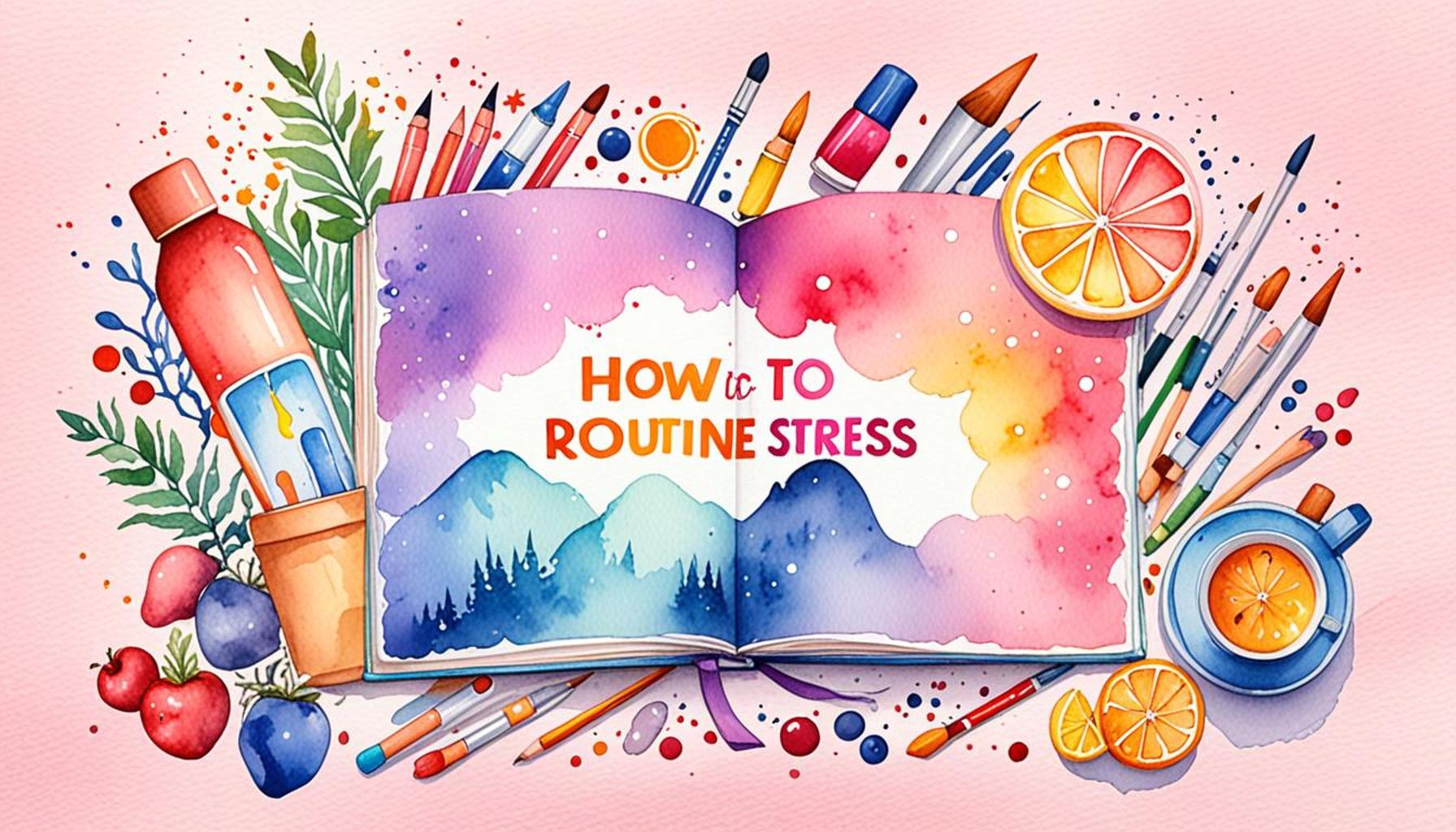Design a Stress-Reducing Routine Proven Strategies for Daily Calm

Finding Your Path to Calm
In today’s fast-paced world, stress can become an unwelcome companion, infiltrating every aspect of our lives. As we juggle work, family, and personal commitments, developing a stress-reducing routine can serve as a vital lifeline. This article explores effective strategies that can pave the way to daily calm and emotional well-being.
Why Design a Routine?
Establishing a calming routine leads to numerous benefits, such as:
- Improved Mental Clarity: A focused mind is a productive mind. When we have a clear structure, it becomes easier to prioritize tasks and make decisions.
- Enhanced Physical Health: Routine activities can boost overall wellness. Regular sleep and meal patterns contribute to sustained energy levels and better metabolism.
- Better Emotional Resilience: Knowing how to respond to stressors helps maintain balance. A consistent routine enables individuals to anticipate challenges and prepare emotionally for them.
But what constitutes an effective routine? It often involves a blend of activities tailored to individual needs. Researchers and health experts advocate for various components, considering what activities resonate particularly with an individual’s lifestyle and preferences.
Key Elements of a Successful Routine
Here are key elements that research has shown to be beneficial:
- Mindfulness Practices: Techniques like meditation, deep breathing, or yoga can ground us in the present moment. For example, the practice of mindful walking encourages participants to focus on their physical sensations, fostering a calm state of mind while integrating physical activity.
- Physical Activity: Regular exercise releases endorphins, often referred to as “feel-good” hormones. Engaging in activities like running, cycling, or even brisk walking can significantly enhance mood and general well-being. The American Heart Association recommends at least 150 minutes of moderate aerobic activity each week, a realistic goal for many individuals.
- Structured Time Blocks: Organizing your day into manageable time blocks can reduce overwhelm and increase productivity. For instance, using techniques such as the Pomodoro Technique, where you work for 25 minutes followed by a 5-minute break, can help maintain focus and prevent burnout.
By understanding and integrating these components into your daily routine, you’ll be better equipped to carve out moments of tranquility amidst the chaos. Additionally, consider the role of personal hobbies or interests, whether it’s reading, gardening, or crafting, as they can provide a much-needed respite from the demands of everyday life.

It’s essential to remember that finding your path to calm is a personal journey. It may take some experimentation to determine which practices best suit your lifestyle and preferences. Exploration of proven strategies that resonate with you can unlock a more peaceful and less stressful life.
SEE ALSO: Click here to read another article
Crafting Your Personalized Calm
The journey to a stress-free life begins with the design of a personalized routine that aligns with your needs and lifestyle. It’s essential to first identify which stress-reducing strategies resonate with you. By incorporating effective methods into your daily schedule, you can create a sanctuary of calm amidst life’s inevitable storms. Below are some proven strategies that have been supported by research and anecdotal evidence, which can serve as building blocks for your own routine.
Establishing a Morning Ritual
Starting the day with intention can greatly influence your overall mood and stress levels. A morning ritual serves not only to awaken your body but also to prepare your mind for the day ahead. Here are some elements that can contribute to an effective morning routine:
- Gratitude Journaling: Spend a few minutes each morning writing down things you are thankful for. This practice can shift focus away from negative thoughts, encouraging a positive mindset as you start your day.
- Mindful Breathing: Engaging in deep, mindful breathing can help reduce anxiety and establish a sense of calm early in the day. Taking just five minutes to concentrate on your breath can create a foundation for tranquility.
- Healthy Breakfast: Prioritizing a nutritious breakfast can significantly impact how you feel throughout the day. Foods rich in Omega-3 fatty acids, whole grains, and proteins fuel the brain and can stave off irritability.
Incorporating Mindfulness Throughout the Day
Mindfulness can be seamlessly integrated into your daily activities, offering frequent doses of calm. Here’s how:
- Mindful Eating: Rather than consuming meals in a rush, take time to savor each bite. This not only enhances your appreciation for food but helps in recognizing hunger and satiety signals.
- Breathing Breaks: Set reminders throughout your workday to pause and take deep breaths. A minute or two of focused breathing can significantly reduce stress levels and enhance concentration.
- Limit Multitasking: Strive to focus on one task at a time. This can improve your efficiency and decrease the likelihood of feeling overwhelmed.
By intentionally weaving mindfulness into your routine, you allow yourself frequent opportunities to recalibrate and reinforce a sense of calm, no matter the chaos around you.
Creating Evening Wind-Down Practices
How you end your day can be just as critical as how you start it. Establishing a calming evening routine can help signal to your body that it’s time to relax and prepare for restful sleep. Consider incorporating these elements:
- Digital Detox: Set a specific time to put away screens. Reducing blue light exposure in the evening enhances melatonin production, leading to better sleep quality.
- Gentle Stretching: Light stretches or yoga can help release tension accumulated throughout the day and promote relaxation.
- Reflective Journaling: Spend a few moments reflecting on your day—what went well and what could improve. This practice not only provides closure but also aids in self-discovery.
Incorporating these evening wind-down practices can create a protective buffer against the stresses of the day, providing you with a smoother journey into restful slumber. Remember, the effectiveness of a stress-reducing routine hinges on consistency and personal resonance, so feel free to experiment and adapt these strategies to suit your unique lifestyle.
| Strategies | Advantages |
|---|---|
| Mindfulness Meditation | Promotes awareness and reduces anxiety, enhancing emotional regulation. |
| Regular Exercise | Boosts endorphins, improves sleep quality, and helps in managing stress effectively. |
| Journaling | Facilitates emotional processing and clarity, enhancing self-awareness. |
| Deep Breathing Techniques | Promotes relaxation and lowers cortisol levels for immediate calming effects. |
| Structured Routines | Creates predictability and stability in daily life, reducing uncertainty-induced stress. |
Implementing proven strategies such as these not only aids in achieving daily calm but also enhances overall well-being. Regular mindfulness meditation helps individuals to focus on the present moment, steering clear of overwhelming thoughts. Exercise, which can include something as simple as a daily walk, plays a crucial role in reducing symptoms of anxiety and improving mood. Journaling, once considered merely a pastime, is now gaining recognition for its therapeutic benefits, offering emotional clarity and insight. Techniques such as deep breathing allow for an immediate response to stressors, quickly bringing the mind and body back to a state of calm. Lastly, developing structured routines offers a reliable framework for organizing one’s day, which can significantly diminish the unpredictability that contributes to stress.By exploring the multifaceted advantages of these strategies, readers are encouraged to delve deeper into the world of stress reduction techniques, discovering personalized approaches that foster lasting tranquility in their daily lives.
CHECK OUT: Click here to explore more
Building Resilience Through Movement and Connection
Physical activity and social connections play pivotal roles in crafting a stress-reducing routine. Engaging in movement not only stimulates physical health but also uplifts mental well-being. Meanwhile, fostering connections with others provides emotional support, which can significantly cushion life’s stresses. Below, you’ll find vital strategies to incorporate these elements into your daily life.
Engaging in Regular Physical Activity
Exercise is a proven method for reducing stress due to the endorphins it releases—neurotransmitters that create a sense of euphoria. Depending on your interests and lifestyle, the following forms of exercise can be effective in managing stress:
- Walking or Jogging: Getting outside for a brisk walk or jog, particularly in nature, has been shown to decrease anxiety and improve mood. Aim for at least 30 minutes throughout your week to reap these mental health benefits.
- Group Classes: Whether it’s yoga, spinning, or dance, engaging in group fitness not only provides a physical outlet but also fosters a sense of community. The shared experience of movement can lead to enhanced motivation and morale.
- Strength Training: Lifting weights can instill a sense of accomplishment and confidence. Studies suggest that strength training is effective in alleviating symptoms of anxiety and depression, making it a powerful stress management tool.
Incorporating physical activity into your daily routine does not necessitate extensive time commitments. Short bursts of movement throughout the day can produce similar benefits, helping to maintain a steady flow of endorphins. Find what resonates with you, and make it a non-negotiable part of your day.
Nurturing Meaningful Connections
The importance of emotional support in stress management cannot be overstated. Building and maintaining meaningful relationships with family and friends acts as a buffer against tension and anxiety. Here are some effective ways to strengthen these bonds:
- Scheduled Social Time: Set aside specific times each week for social interactions, whether it be a phone call, video chat, or meet-up. Regular connection reinforces your support network and fosters a sense of belonging.
- Join Clubs or Groups: Engaging in hobby-based clubs or community organizations is an excellent way to meet like-minded individuals. Adopting shared goals and interests can enhance support and camaraderie.
- Practice Active Listening: When interacting with others, focusing on understanding rather than responding can deepen relationships. Active listening fosters a supportive environment that encourages open communication.
Research has shown that maintaining social interactions can lead to reductions in stress hormones and lower levels of anxiety. Being able to turn to someone during moments of discomfort provides comfort and reassurance, making social bonds an essential component of any stress-reducing routine.
Embracing Nature for Enhanced Calm
Spending time in nature offers profound benefits for mental wellness. Exposure to natural environments can lower stress levels, enhance mood, and boost overall well-being. Here are practical ways to integrate nature into your routine:
- Nature Walks: Make it a goal to visit local parks or green spaces. Walk among trees, immerse yourself in flowers, and listen to the sounds of nature. Even short excursions can have restorative effects on your mental state.
- Gardening: This engaging activity promotes mindfulness and allows you to connect with the earth. The act of nurturing plants not only provides satisfaction but also enhances understanding of life cycles and patience.
- Outdoor Mindfulness Practices: Combine mindfulness or meditation practices with outdoor settings. Practices like tai chi or yoga conducted in parks or backyards can amplify the benefits of both mindfulness and a natural environment.
Integrating elements of movement, connection, and nature can create an enriching framework for stress relief. Each of these strategies contributes to a balanced routine, enabling you to better navigate the complexities of daily life while supporting your overall calm and resilience.
SEE ALSO: Click here to read another article
Conclusion: Crafting Your Path to Everyday Calm
In a world filled with relentless demands and unceasing pressures, cultivating a stress-reducing routine is essential for maintaining daily calm. By implementing effective strategies that embrace physical activity, social connections, and the healing advantages of nature, you can design a personalized blueprint for resilience and inner peace. Each element—from engaging in regular exercise that floods your system with endorphins to nurturing meaningful relationships that provide emotional support—contributes to a holistic approach to stress management.
It is important to prioritize these activities in your life. Consider setting aside specific times for physical workouts, social interactions, and moments of tranquility in nature. This approach not only fosters consistency but also reinforces your commitment to wellness. Remember, even small actions can have profound effects—30 minutes of walking or a short gardening session can create a ripple of positive outcomes in your mental health.
As you explore these strategies, stay attuned to what resonates with you, adapting your routine to fit your individual needs and preferences. By taking charge of your daily calm, you are not just alleviating stress; you are investing in your overall well-being and nurturing a sustainable lifestyle. The journey to a more peaceful existence begins with consistent practice, so embrace the quest and enjoy the transformative experience along the way.
Ultimately, the quest for daily calm is a journey unique to each individual, and the most effective routines are those that are continually refined and personalized. Take the first step today, and discover how these proven strategies can enhance your well-being and guide you towards a more serene and fulfilling life.



